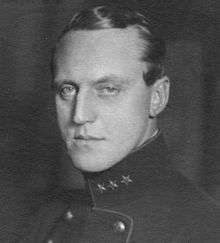Carl Årmann
| Carl Årmann | |
|---|---|
 | |
| Birth name | Carl Nils Gabriel Årmann |
| Born |
24 August 1894 Stora Mellösa, Sweden |
| Died |
21 April 1988 (aged 93) Stockholm, Sweden |
| Allegiance | Sweden |
| Service/branch | Swedish Army |
| Years of service | 1915–1964 |
| Rank | Lieutenant General |
| Commands held | III. Military Area (1950–51) |
| Other work | Head of National Swedish War Materials Inspectorate (1960–64) |
Carl Nils Gabriel Årmann (24 August 1894 – 21 April 1988)[1] was a Swedish Army general and modern pentathlete. He competed at the 1924 Summer Olympics and finished tenth.[2]
Career
Årmann was born in Stora Mellösa, Sweden and was the son of estate owner Nils Årmann and Alva (née Lange). He passed studentexamen in Örebro in 1913.[3] Årmann became a second lieutenant at Uppland Artillery Regiment (A 5) in 1915 and completed the higher course at the Artillery and Engineering College from 1918 to 1920 and was captain of the General Staff in 1926. Årmann was teacher at the Artillery and Engineering College from 1928 to 1934 and served at Uppland Artillery Regiment (A 5) in 1934.[4]
He was major of the General Staff in 1936 and was promoted to lieutenant colonel in 1939 and served at Uppland Artillery Regiment (A 5) in 1940. Årmann was promoted to colonel in 1941 and was appointed head of the Artillery and Engineering College in 1941 and commander of the Norrland Artillery Regiment (A 4) in 1942 and the Bergslagen Artillery Regiment (A 9) in 1943.[4]
Årmann was military commander of III. Military Area in 1950 (acting in 1946) and was promoted to major general in 1950 and lieutenant general in 1960. He was then the Chief of the Military Office of the Swedish Minister of Defence (Försvarets kommandoexpedition) from 1951 to 1960 and was head of the National Swedish War Materials Inspectorate at the Ministry of Trade from 1960 to 1964.[4]
Other work
Årmann became chairman of the Skövde Flying Club in 1946 and of the Skövde department of the Swedish Outdoor Association (Skid- och friluftsfrämjandet) in 1946.[5] He was a member of the Enrollment Council (Inskrivningsrådet) in 1955[6] and became a member of the Royal Swedish Academy of War Sciences in 1944.[4]
Personal life
In 1926 he married Brita Flach (born 1902), the daughter of estate owner Erik Flach and Tyra (née Schubert). Årmann was the father of Jan (born 1928) and Christina (born 1931).[6]
Awards and decorations
Årmann's awards:[6]
- Commander Grand Cross of the Order of the Sword
- Knight of the Order of Vasa
- Commander First Class of the Order of the Dannebrog
- Commander First Class of the Order of the White Rose of Finland
- Commander First Class of the Order of St. Olav
- Commander of the Legion of Honour
- Third Class of the Order of the Cross of Liberty with swords
- Home Guard Gold Medal of Merit (Hemvärnets förtjänstmedalj i guld)
- Equestrian Olympic Medal (Ryttarolympisk förtjänstmedalj)
References
- ↑ "Carl Årmann" (in Swedish). Swedish Olympic Committee. Retrieved 2 December 2015.
- ↑ "Carl Årmann Olympic Results". Sports-reference.com. Retrieved 2012-06-22.
- ↑ Vem är det: svensk biografisk handbok. 1943 [Who is it: Swedish biographical handbook. 1943] (in Swedish). Stockholm: Norstedt. 1940. p. 940.
- 1 2 3 4 Lagerström, Sten, ed. (1968). Vem är det: svensk biografisk handbok. 1969 [Who is it: Swedish biographical handbook. 1969] (in Swedish). Stockholm: Norstedt. p. 1074.
- ↑ Harnesk, Paul, ed. (1948). Vem är vem?. D. 3, Götalandsdelen utom Skåne [Who is Who?. D. 3, Götaland part except Scania] (in Swedish). Stockholm: Vem är vem bokförlag. p. 1062.
- 1 2 3 Harnesk, Paul, ed. (1962). Vem är vem? 1, Stor-Stockholm [Who is who? 1, Greater Stockholm] (in Swedish) (2nd ed.). Stockholm: Vem är vem. p. 1452.